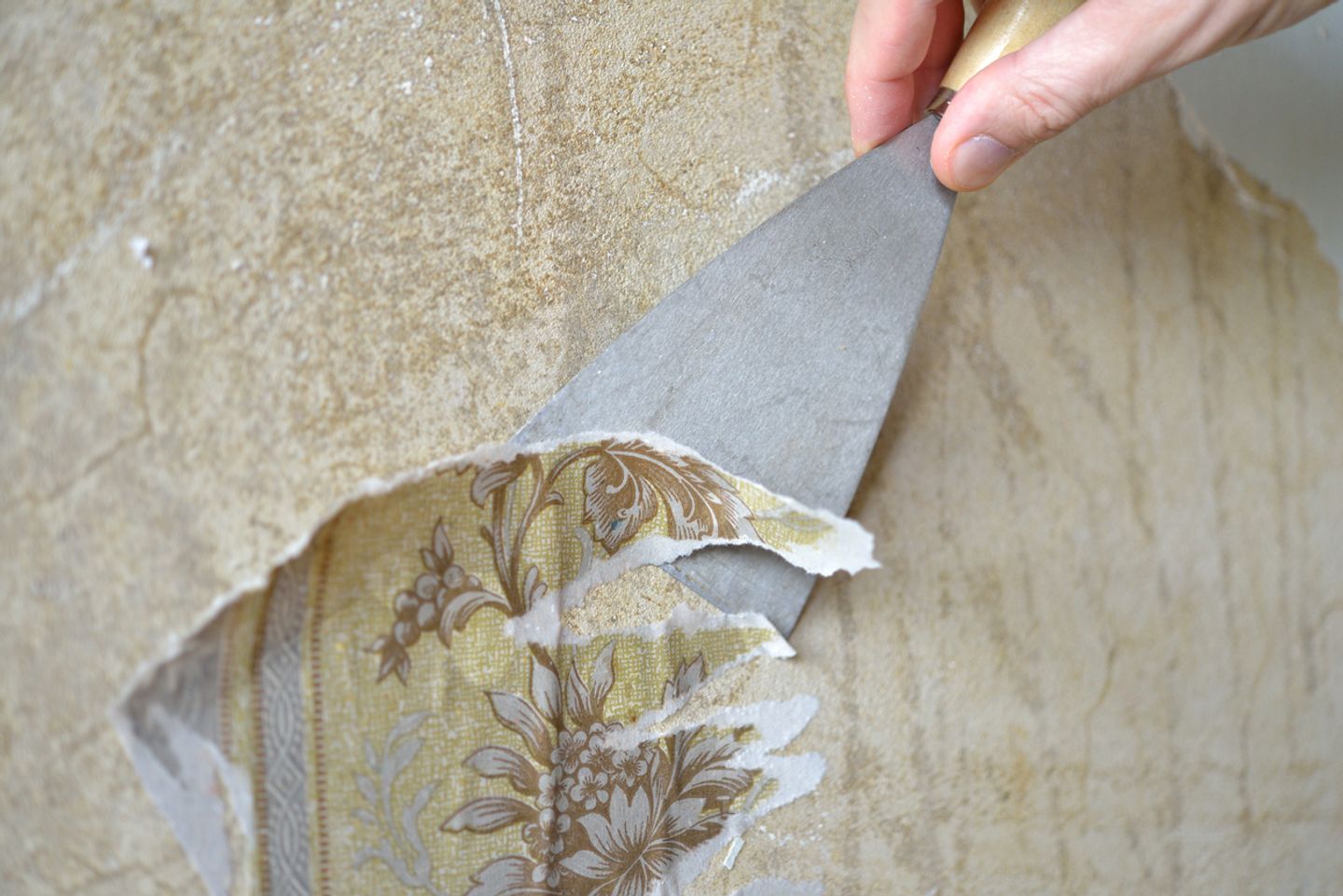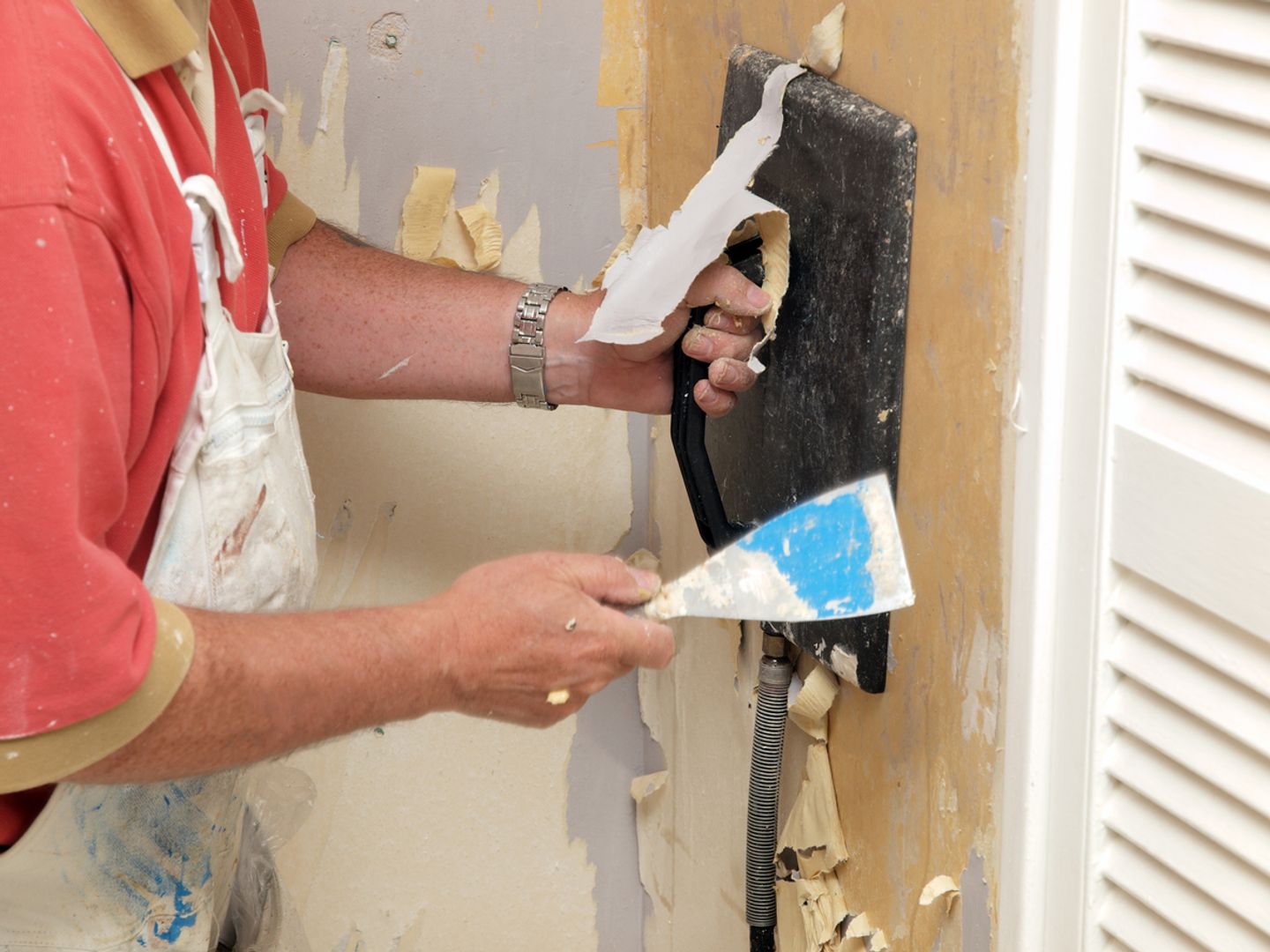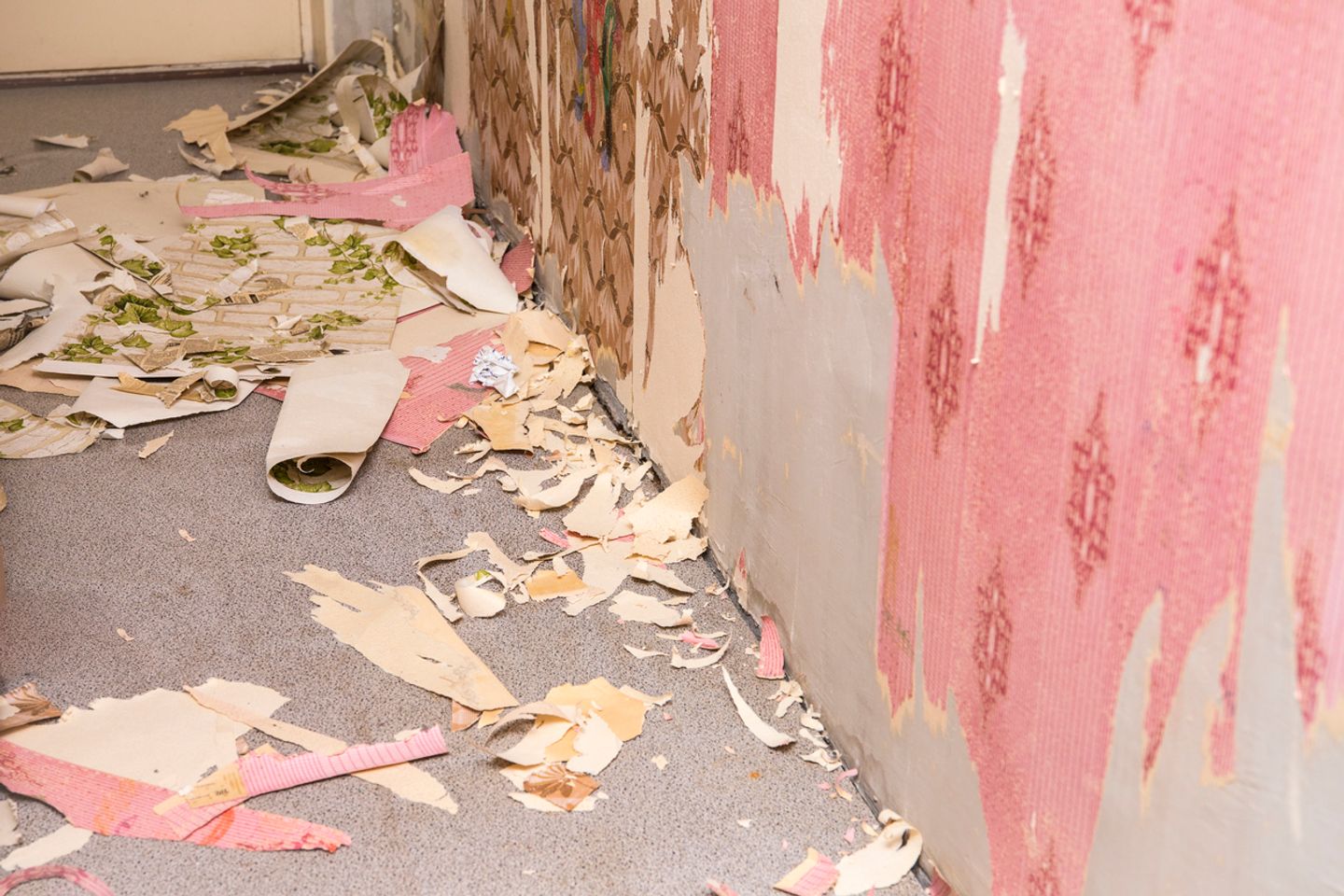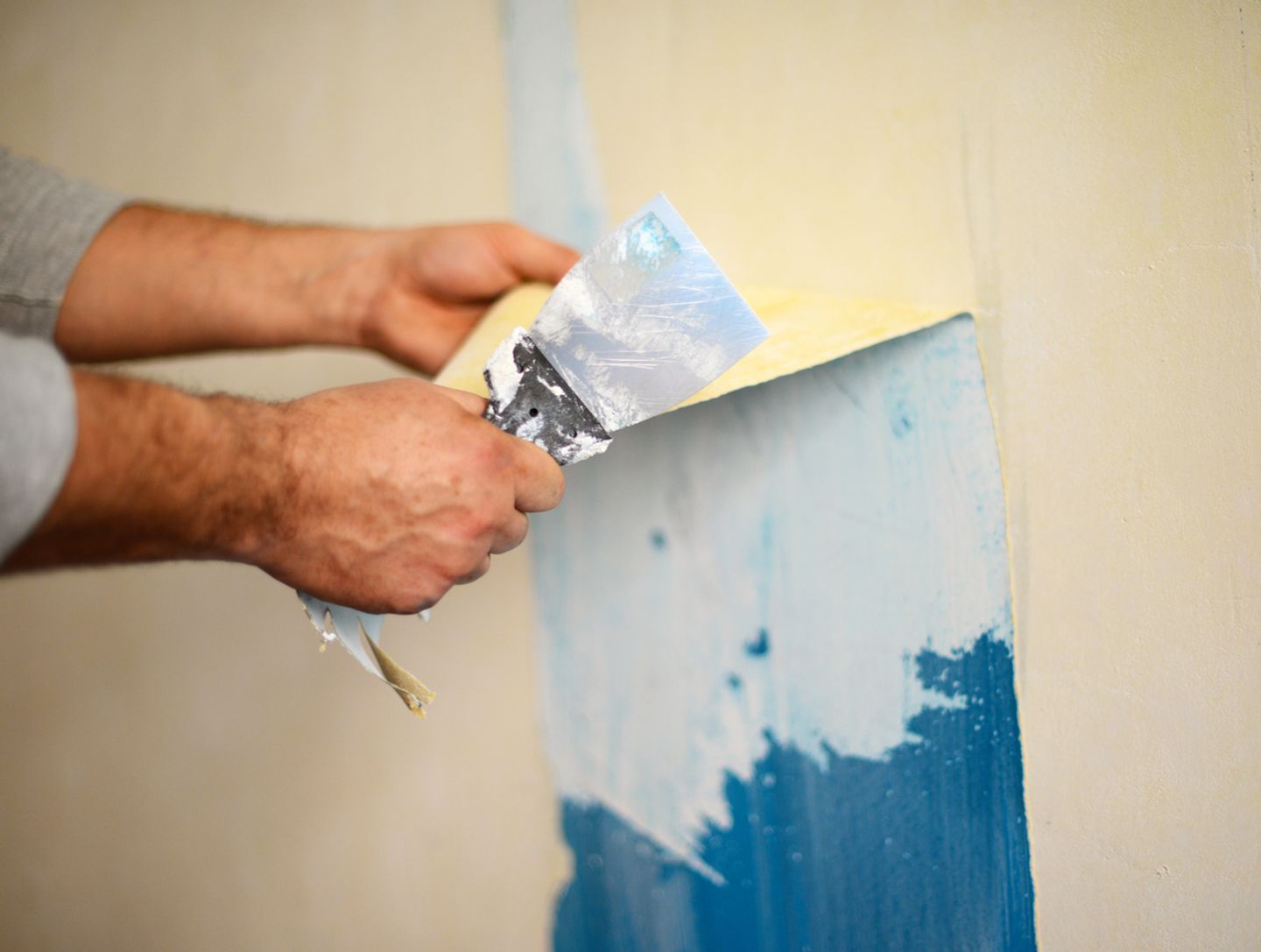Becoming a first-time buyer is a rite of passage. It’s an experience filled with joy, relief and anticipation. But if it’s a property that’s time-worn, this new, exciting chapter of your life can quickly become arduous where redecorating is concerned. There’s a good chance you'll have some wallpaper projects crops up along the way and as the saying goes, what goes up must come down! But what’s the best way to remove wallpaper without tearing your hair out in the process? In this article, we’ll discuss everything from steamers, stripping wallpaper and other solutions to remove wallpaper.
Wallpaper removal preparation
While it’s all too tempting to start tearing down that garish 1970s wallpaper hanging in your front room, you first need to make sure the area is safe and you follow the safety precautions below before stripping your wallpaper:
- Use dust sheets to cover any exposed areas. Stripping wallpaper gets messy fast, and you won’t want old glue sticking to your floor.
- Place masking tape over nearby electrical sockets to avoid dripping water on live wires. It’s also best to turn the power off at the mains.
- Wear safety goggles to protect your eyes from debris, falling paper, and hot water.
- Find a ladder that’s suitable for your wall and space. For instance, if you’re stripping paper from a stairwell, an articulated ladder will offer increased stability thanks to its several locking hinges.
- Ensure chemicals and adhesives are carefully stored away and out of reach from anyone entering the room. We also recommend wearing thick, protective gloves.
Find out what wallpaper is present
The key to quickly removing wallpaper is first to assess the room. Which method you use will depend on several factors, including what material your walls consist of and how easily the paper peels away. Start by using a putty knife to gently loosen a corner of the paper before slowly peeling it back. If you tear the wallpaper straight off, it could damage the wall.
If the paper comes away from the wall easily, then you have strippable wallpaper which is easier to remove. Likewise, if a paper backing is left on the wall when you strip away the pieces, you’re probably dealing with peelable wallpaper.
The most enduring wallpaper to remove is the traditional type, which doesn’t budge a millimetre when tested with a dry putty knife. In these instances, you’ll need a chemical stripper, but more on that shortly.

Credit:-lvinst- URL: https://www.istockphoto.com/
Drywall or plaster?
Did you know the type of walls you have in your home can affect how your wallpaper is removed? You can find out what your wall is made of by simply giving it a tap — if it sounds hollow, it’s probably drywall.
If it is drywall, you won’t want to risk using any heavy detergents or excessive water when stripping wallpaper. Drywall typically consists of mineral gypsum, which isn’t as hardy as plaster and will damage easily when over soaked.
If your wall has a much denser, colder finish, it’s most probably plaster. This material is typically constructed with robust sand, cement, lime, and water, which gives you more options when finding the best way to remove wallpaper.
The two easiest ways to remove wallpaper
Once you know what materials are used in your walls, you need to settle on a method for removing the paper. There are generally two options that are the easiest for wallpaper stripping & they are:
- A chemical stripping solution
- An electric steam wallpaper stripper
Let’s discuss the merits and limitations of both methods.

Credit:Gannet77 URL: https://www.istockphoto.com/
How to remove wallpaper with a steamer
If you have strippable or peelable wallpaper, the chances are that you can remove the bulk of it with a wallpaper steamer. These devices consist of a water tank connected to a steam plate. Steaming works best on large surfaces, and particularly on drywalls, reducing the risk of damage.
If used correctly, the steam will enter the perforated wallpaper and activate its adhesive, causing the paper to slide away. Steaming makes removing wallpaper faster, easier and less stressful than using traditional methods.
Best of all, wallpaper strippers are relatively inexpensive to hire and are ready to use in just 15 minutes. Head to our online store to find professional wallpaper strippers built for removing everything from vinyl to woodchip.
You will need:
- A steam wallpaper stripper
- A wooden board or a hard surface table to sit the device on and stop heat damage.
- Dust or polythene sheets
- A jug of cold water (to fill the steam stripper)
- Protective gloves
- Wallpaper scraper
- Putty knife
- Protective goggles
- Masking tape
- Broom or dustpan and brush
Step-by-step instructions:
- Fill the device with water and wait for steam to exit from the plate.
- While you’re waiting, score the wallpaper in sections so that it’s easier for steam to enter the material. Scoring the paper at the top of the wall using a utility knife and straight edge also helps to prevent damage to your ceiling.
- Starting at the bottom of the wall, hold the steamer to the wallpaper for around 10 seconds. The steam should soften the paper and any adhesive.
- As you move the steamer upwards, pull the dampened paper off with a stripping knife. If you can, stop the paper from collecting on the dust sheets as the old adhesive will start to cool and stick around your feet.
- Once you’ve removed all paper, brush the wall with a stiff broom to remove any remaining debris. You may need to use the stripping knife to peel off any pieces that didn’t fall away.
- If there is wallpaper paste present, we recommend sponging it with a stripping solution. Once dried, it should come off with a scraper.
How to remove wallpaper without a steamer
If you don’t have a steamer or there’s wallpaper that won’t budge, you might need to resort to using a bit of old-fashioned elbow grease mixed with some stripping solution. These ready-to-use chemical liquids help dissolve wallpaper adhesive and are ideal if you’ve got more than one layer to remove.
Many stripping solutions come in a spray bottle for easy application, while others need diluting with water so make sure to read the label before applying. if you’re in a rush or don’t have access to chemicals, it’s pretty easy to make your own solution. Simply mix liquid detergent and hot water in a bowl.
Just a word of warning: some untested detergents may not work as well as the best wallpaper removal solutions and could damage your walls so buy a product from a well-known brand where you can.
You will need:
- Stripping solution
- A bucket and sponge or spray bottle
- Dust or polythene sheets
- Wallpaper scraper
- Putty knife
- Protective clothing
- Masking tape
- Broom or dustpan and brush
Step-by-step instructions:
- Score the wallpaper first to ensure the stripping solution will be properly absorbed.
- Apply the stripping solution with either a sponge, spray bottle or paint roller, making sure not to oversoak the paper. Some products have a non-staining yellow formula that allows you to see where you’ve sprayed.
- Once the paper is suitably damp, carefully use a stripping knife to scrape away each piece. You should keep the blade flat and avoid digging it into the wall’s surface.
- If the stripping solution starts to dry, apply more.
- Finally, brush the wall with a stiff broom to remove any remaining debris. You may need to reapply the solution onto any sections of your wall that have leftover adhesive or backing paper.

(Credit:Helin Loik-Tomson) URL: https://www.istockphoto.com/
Once all the wallpaper and residual glue has been removed, the hard part is over! There is, however, one thing left to do and that’s clean the walls. It might sound unnecessary after you've been sweating over a steamer & stripping knife for several hours but if you don’t clean the walls, you won't get a smooth finish.
So, here’s what to do:
- Use a sponge or cloth and a bucket of warm water to wipe the walls clean. You may find adding a few squirts of washing up liquid helps.
- If any residual pieces of paper or adhesive remain on the walls, use more stripping solution and scrape it off & wipe the walls again.
- Once fully clean, rub the area down with a towel and leave to dry overnight before applying with paint/wallpaper.
- You may find that some parts of your wall need repairing or have screw holes, in which case you should use the appropriate filler and sand flush.
And that’s it! You've got a clean, smooth, paper-less wall ready for redecorating.
If you’re working on a bigger DIY project, why not check out some other how-to guides on our blog page. Alternatively, head over to our website where you’ll find all the tools you need to complete your dream makeover project.
For any questions or queries, get in touch with our live chat experts who are on hand & happy to help or contact your local HSS branch.






















































